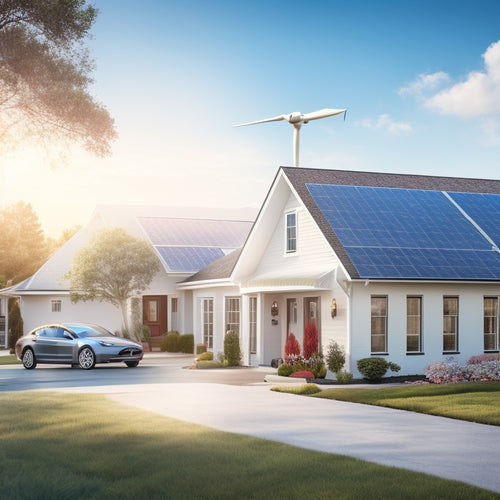
Why Are Home Solar Panels So Expensive?
Share
When you invest in a home solar panel system, you're paying for more than just the panels themselves. The overall cost is influenced by a complex array of factors. High-performance materials, skilled labor, and necessary permits all add up. You're also paying for inverters, mounting hardware, and potentially, energy storage upgrades. Permitting and inspection fees, electric grid connection charges, and profit margins all contribute to the expense. Even roof size and complexity can impact the final cost. As you navigate the world of home solar panels, you'll uncover more nuances that affect the bottom line, and a closer look can reveal surprising insights.
Key Takeaways
• High-quality solar panels with high-efficiency conversion rates and durable materials, like monocrystalline silicon, increase the overall cost.
• Labor costs for skilled installation, project management, and permitting add to the expense of home solar panel systems.
• The cost of inverters, mounting hardware, and energy storage systems, which ensure efficient energy conversion and storage, contributes to the expense.
• Permitting and inspection fees, which vary by location, can range from $500 to $2,000 or more, adding to the overall cost.
• Profit margins, sales taxes, and market trends also impact the final cost of home solar panel systems, making them more expensive.
High-Quality Panel Materials Cost
With high-efficiency solar panels boasting conversion rates of up to 22%, premium materials like monocrystalline silicon and high-purity metals noticeably increase the cost of your home solar panel system. You might be thinking, 'What makes these materials so special?' Well, it's all about importance.
Monocrystalline silicon, for instance, has a more uniform crystal structure, allowing it to convert sunlight into energy more effectively. High-purity metals, on the other hand, enhance the flow of electrical current. The result? More power per panel, and a higher price tag.
Efficient manufacturing processes also play an important role in the cost of your solar panel system. Manufacturers like Tesla and Panasonic have developed innovative production methods that minimize waste and maximize output. This attention to detail doesn't come cheap, but it guarantees that each panel meets the highest standards of quality and performance.
Material science also plays a significant role, as researchers continually experiment with new materials and designs to boost efficiency. While these advancements come at a cost, they're essential for creating high-performance solar panels that can power your home reliably.
Installation Labor and Overhead
When you invest in high-performance solar panels, you'll also need to factor in the labor costs associated with installing and integrating these advanced systems into your home's electrical infrastructure. This is where the skilled workforce comes in – highly trained technicians who can guarantee a seamless installation process. Their expertise doesn't come cheap, and you'll need to budget for their time and effort.
Project management is also an important aspect of the installation process. Coordinating with local authorities, obtaining permits, and overseeing the entire operation requires a significant amount of time and resources. These overhead costs are typically factored into the overall installation quote, adding to the final bill.
While it's tempting to cut corners and opt for a DIY installation, this can lead to subpar performance, safety risks, and even void your warranty. By hiring a reputable installer, you're ensuring a high-quality installation that will maximize your energy savings and provide peace of mind.
Inverter and Mounting Hardware Costs
When assessing the overall cost of your home solar panel system, it's crucial to take into account the inverter and mounting hardware costs.
You'll need to factor in the cost of the inverter, which converts DC power to AC power, as well as the mounting hardware that secures the solar panels to your roof.
Inverter Cost Breakdown
Your inverter cost breakdown typically includes two primary components: the inverter itself and the necessary mounting hardware. You might be wondering, what makes up the bulk of the cost? Let's explore.
The inverter itself is a significant contributor to the overall cost. You see, a high-quality inverter is built to last, with inverter durability being a top priority. This means manufacturers use premium materials and advanced technologies to guarantee seamless power optimization. This attention to detail comes at a price, but it's worth it in the long run. A reliable inverter can save you from costly repairs and replacements down the line.
The mounting hardware, on the other hand, is important for securing the inverter and ensuring its efficient operation. While it may not be as expensive as the inverter itself, it's still an essential component that adds to the overall cost.
Hardware Component Prices
How much are you willing to spend on inverter and mounting hardware, considering that these components greatly impact your solar panel system's performance and longevity?
The answer lies in understanding the production costs and manufacturing efficiencies that drive their prices.
Inverters, which convert DC power to AC, are an essential component of your solar panel system. High-quality inverters with advanced features like maximum power point tracking (MPPT) and monitoring capabilities come at a premium. Expect to pay around $0.15 to $0.30 per watt, depending on the inverter's capacity and features. That's $3,000 to $6,000 for a typical residential system.
Mounting hardware, including racking and tracking systems, also adds to the overall cost. These components must be durable and corrosion-resistant to withstand harsh outdoor conditions. While they may seem like a minor expense, high-quality mounting hardware can cost upwards of $1,000 to $2,000 for a typical residential installation.
Permitting and Inspection Fees
As you navigate the process of installing solar panels on your home, you'll need to comply with local government regulations, which will likely involve obtaining permits and undergoing inspections. These requirements will add to your overall cost, and you'll need to factor in the costs of permits, inspections, and potential bureaucratic delays.
You'll want to understand the specific regulations in your area and budget accordingly to avoid unexpected expenses.
Local Government Regulations
Local governments impose regulations on home solar panel installations, requiring homeowners to obtain permits and undergo inspections, which add to the overall cost. You might think, 'What's the big deal? It's just some paperwork, right?' Not quite. These regulations can be a significant hurdle, and the costs can add up quickly.
Zoning restrictions, for instance, dictate where and how you can install your solar panels. If you live in a historic district or a neighborhood with strict aesthetic guidelines, you might need to jump through extra hoops to get approval. And then there are building codes, which guarantee your installation meets safety standards. While these codes are essential, they can also drive up costs.
As you navigate the regulatory landscape, you'll likely need to hire professionals to help with the permitting process. This can be time-consuming and expensive. It's not uncommon for homeowners to spend thousands of dollars just to comply with local regulations.
Inspection and Permit Costs
You'll need to budget for permitting and inspection fees, which can range from $500 to $2,000 or more, depending on the complexity of your solar panel installation and the jurisdiction in which you live. These costs can add up quickly, and it's crucial to factor them into your overall budget.
Permitting fees cover the cost of plan review, inspections, and code enforcement. Think of it as a 'fee' for the privilege of generating clean energy. Municipal requirements vary, and some jurisdictions are more stringent than others. You might need to obtain multiple permits, each with its own set of fees.
Inspection fees, on the other hand, ensure that your solar panel installation meets local building codes and safety standards. Code enforcement officials will inspect your installation to verify compliance.
While these fees might seem like an added burden, they're necessary for ensuring your safety and the integrity of the electrical grid. So, be prepared to shell out some cash to cover these necessary expenses.
Bureaucratic Red Tape
Navigating the bureaucratic red tape of permitting and inspection fees can be a frustrating and time-consuming process, requiring you to invest significant time and effort into paperwork, applications, and compliance. This process is akin to trying to navigate a maze blindfolded while being chased by a pack of paperwork-wielding bureaucrats.
| State | Permitting Fees | Inspection Fees |
|---|---|---|
| California | $500 - $1,000 | $200 - $500 |
| New York | $300 - $700 | $150 - $300 |
| Texas | $200 - $500 | $100 - $200 |
| Florida | $400 - $800 | $250 - $500 |
| Illinois | $250 - $600 | $150 - $300 |
Government inefficiencies and policy loopholes only add to the complexity, making it challenging for homeowners to navigate the system. The costs of permits and inspections can vary widely depending on your location, adding to the overall expense of going solar. Factor these costs into your budget and plan accordingly to avoid any unexpected surprises. By understanding the bureaucratic hurdles involved, you can better prepare yourself for the journey ahead.
Energy Storage System Upgrades
Upgrading your energy storage system enables you to optimize your solar panel system's performance and increase your energy independence. It's like leveling up your solar game! With a battery backup, you can store excess energy generated during the day for use during the night or during power outages. It's like having a superpower – you can be your own utility company!
Smart charging technology guarantees that your batteries are charged efficiently, so you can maximize your energy savings. Think of it as having a personal energy butler, making sure your batteries are always topped up and ready to go.
Roof Size and Complexity Issues
When evaluating the feasibility of a home solar panel installation, your roof's size and complexity can greatly influence the overall system design and cost. A smaller roof with multiple obstructions like skylights, vents, or chimneys can make it challenging to find sufficient space for solar panels. This may require a more complex system design, which increases the cost.
On the other hand, a larger roof with few obstructions can accommodate more panels, making it a more cost-effective option.
Additionally, the structural integrity of your roof is important. If your roof requires repairs or replacement, it may be necessary to do so before installing solar panels. This can add to the overall cost of the installation.
Roof obstructions can also impact the system's performance. For instance, if panels are installed around obstructions, they may not receive direct sunlight, reducing the system's energy output.
A thorough assessment of your roof's size and complexity is essential to determine the most suitable system design and achieve a successful installation.
Electric Grid Connection Charges
When preparing for your home solar panel installation, you'll need to factor in the costs associated with connecting your system to the electric grid, which can vary depending on your utility company's policies and local regulations. This is where Grid Access charges come in - think of it as a membership fee to join the grid party. You'll need to pay Connection Fees, which can range from a few hundred to several thousand dollars, depending on the complexity of the connection.
These fees cover the cost of upgrading the grid infrastructure to accommodate your solar power system.
You'll also need to take into account Utility Rates, which are the prices you pay for the electricity you consume from the grid when the sun isn't shining.
And let's not forget Transmission Costs, which are the costs of maintaining and operating the grid itself. These costs can add up, but don't worry, you'll be generating your own clean energy and saving on your electricity bill in no time! Just remember, it's like buying a ticket to the grid rodeo - you gotta pay to play.
Profit Margins and Sales Taxes
As you finalize the cost breakdown for your home solar panel installation, you'll need to factor in the profit margins of the installation company and sales taxes on the system's components, which can add a significant percentage to your overall expense.
Profit margins vary among installation companies, but a typical range is between 10% to 20% of the total system cost. This means that for a $20,000 system, the installation company's profit could be anywhere from $2,000 to $4,000.
Here are three key points to take into account:
-
Market trends: The solar industry is becoming increasingly competitive, which can drive down profit margins. However, installation companies may still charge higher prices to maintain their profit margins.
-
Tax incentives: While the cost of sales taxes can be significant, you may be able to claim a portion of these taxes as a credit on your tax return.
-
Negotiation is key: Be prepared to negotiate with installation companies to get the best deal. A little haggling can go a long way in reducing your overall cost.
Frequently Asked Questions
Can I Install Solar Panels Myself to Save Money?
"Hey, DIY enthusiast! You're tempted to install solar panels yourself to save some bucks, but beware: DIY difficulties can lead to safety risks and inefficient energy output, ultimately offsetting installation costs."
Are Solar Panels More Expensive for Larger Homes?
When you're sizing up solar panels for your larger home, remember that roof size limitations and energy requirements play a big role in pricing; more panels means more cost, so be prepared for a heftier bill!
Do Solar Panels Work Efficiently in Shaded Areas?
When you install solar panels in shaded areas, you'll face energy loss due to reduced sunlight. Look for panels with high shade tolerance to minimize efficiency drops, but be prepared for some energy loss, sorry to say!
Can I Finance My Solar Panel System Through a Loan?
You can finance your solar panel system through a loan, and your credit score will impact the interest rate you're offered; explore loan options from banks, credit unions, or specialized solar lenders to find the best fit for you.
Are There Any Government Incentives for Solar Panel Installation?
You're in luck! The government's got your back with tax credits and rebate programs to offset the cost of going solar. You can claim a federal tax credit of up to 26% of your system's cost.
Related Posts
-

Why Homeowners Are Embracing DIY Energy Independence
By taking control of your energy needs, you're breaking free from the uncertainty of utility bills and embracing a se...
-

What Role Do Unicycles Play in Urban Transport?
As you navigate through congested city streets, unicycles emerge as a viable solution, slashing carbon emissions by u...
-

What Are the Average Cost Savings of Solar Panels
You can expect to save between $400 and $1,000 per year on your electricity bills with solar panels, which translates...


